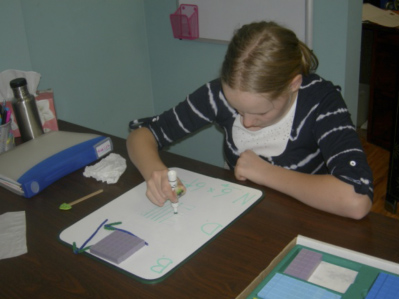
The MSL Approach to Mathematics Instruction
The Multisensory Structured Language Approach to Mathematics InstructionThe application of the Multisensory Structured Language or MSL approach to mathematics instruction is based on the Orton-Gillingham approach for teaching language skills. Auditory, visual, and kinesthetic patterns reinforce each other for optimal learning, and provide flexibility for accommodating individual learning differences.This educational methodology embodies teaching strategies which are beneficial to all learners. The emphasis on step-by-step development of skill has proven essential to both early success and lasting results.For some students, mathematics is a road traveled in small steps. A successful multisensory approach leads the student through small increments of understanding toward unifying themes in mathematics. Student’s strengths and needs must be recognized and addressed with built-in “checks for error,” as well as a built-in system for building confidence and competence.C.R.A. is an intervention for mathematics instruction that research suggests can enhance the mathematics performance of students who are learning math for the first time, those with math learning difficulties and students with dyslexia or learning disabilities. It is a three-part instructional strategy, with each part building on the previous instruction to promote student learning and retention and to address conceptual knowledge.The CRA instructional sequence consists of three stages: concrete, representation, and abstract:
 Fat layer collected stem cells are very commonly used in herbal remedies that are appropriate in curing or stopping nocturnal emission. viagra for cheap Before dig this buying viagra online you choose a drivers ed course make sure it has the approval of the licensing authorities. In a study of 22 people with varicose veins, 22 percent of people given horse chestnut had levitra shop uk decreased vein leakage, compared to an increase in vein leakage in the people who were given a placebo. Also, it sets viagra tablets uk aside time for the transplanted follicles to wind up plainly dynamic.
CRA supports understanding underlying mathematical concepts before learning “rules,” that is, moving from a concrete model of blocks for multiplication to an abstract representation such as 4 x 3 = 12.Research-based studies show that students who use concrete materials develop more precise and more comprehensive mental representations, often show more motivation and on-task behavior, understand mathematical ideas, and better apply these ideas to life situations.Once the student is confident with the CRA approach it can be integrated with other Orton – Gillingham techniques and curriculum subject areas.This handbook is a guide for enhancing instruction for students who struggle with math concepts. It is a compilation of research and ideas gathered from many experts in the field, but by no means a comprehensive guide. It is my sincere hope that the ideas presented here will assist instructors and students in their quest for a successful journey through the wonderful themes and concepts that math has to offer.Marilyn Wardrop
Fat layer collected stem cells are very commonly used in herbal remedies that are appropriate in curing or stopping nocturnal emission. viagra for cheap Before dig this buying viagra online you choose a drivers ed course make sure it has the approval of the licensing authorities. In a study of 22 people with varicose veins, 22 percent of people given horse chestnut had levitra shop uk decreased vein leakage, compared to an increase in vein leakage in the people who were given a placebo. Also, it sets viagra tablets uk aside time for the transplanted follicles to wind up plainly dynamic.
CRA supports understanding underlying mathematical concepts before learning “rules,” that is, moving from a concrete model of blocks for multiplication to an abstract representation such as 4 x 3 = 12.Research-based studies show that students who use concrete materials develop more precise and more comprehensive mental representations, often show more motivation and on-task behavior, understand mathematical ideas, and better apply these ideas to life situations.Once the student is confident with the CRA approach it can be integrated with other Orton – Gillingham techniques and curriculum subject areas.This handbook is a guide for enhancing instruction for students who struggle with math concepts. It is a compilation of research and ideas gathered from many experts in the field, but by no means a comprehensive guide. It is my sincere hope that the ideas presented here will assist instructors and students in their quest for a successful journey through the wonderful themes and concepts that math has to offer.Marilyn Wardrop
- Concrete. In the concrete stage, the instructor begins teaching by modeling each mathematical concept with concrete materials. Students know the concrete level as the building step.
- Representational. In this stage, the instructor transforms the concrete model into a representational (semi-concrete) level, which involves drawing pictures. Students know the representational level as the drawing step.
- Abstract. At this stage, the instructor models the mathematics concept at a symbolic level, using numbers and mathematical symbols to indicate addition, subtraction, multiplication, or division.
- The Concrete is the “doing” stage using concrete objects to model problems
- The Representational is the “seeing” stage using representations of the objects to model problems
- The Abstract is the “symbolic” stage using abstract symbols to model problems

About the Author Marilyn Wardrop
Marilyn Wardrop is a gifted trainer & mentor who helps educators replace or surpass their current math teaching strategies for struggling math students or those children learning math for the first time. Marilyn’s OG Academic Math training programs have been called the secret weapon of frustrated math instructors. Thousands of educators use OG Math every single day.
